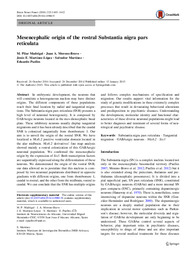Por favor, use este identificador para citar o enlazar este ítem:
https://hdl.handle.net/11000/35383Registro completo de metadatos
| Campo DC | Valor | Lengua/Idioma |
|---|---|---|
| dc.contributor.author | Madrigal Verdú, Pilar | - |
| dc.contributor.author | Moreno-Bravo, Juan Antonio | - |
| dc.contributor.author | Martínez-López, Jesús E. | - |
| dc.contributor.author | Martinez, Salvador | - |
| dc.contributor.author | Puelles, Eduardo | - |
| dc.contributor.other | Departamentos de la UMH::Histología y Anatomía | es_ES |
| dc.date.accessioned | 2025-01-28T12:12:20Z | - |
| dc.date.available | 2025-01-28T12:12:20Z | - |
| dc.date.created | 2016 | - |
| dc.identifier.citation | Brain Structure and Function. 2016 Apr;221(3):1403-12 | es_ES |
| dc.identifier.issn | 1863-2661 | - |
| dc.identifier.issn | 1863-2653 | - |
| dc.identifier.uri | https://hdl.handle.net/11000/35383 | - |
| dc.description.abstract | In embryonic development, the neurons that will constitute a heterogeneous nucleus may have distinct origins. The different components of these populations reach their final location by radial and tangential migrations. The Substantia nigra pars reticulata (SNR) presents a high level of neuronal heterogeneity. It is composed by GABAergic neurons located in the mes-diencephalic basal plate. These inhibitory neurons usually display tangential migrations and it has been already described that the caudal SNR is colonized tangentially from rhombomere 1. Our aim is to unveil the origin of the rostral SNR. We have localized a Nkx6.2 positive ventricular domain located in the alar midbrain. Nkx6.2 derivatives' fate map analysis showed mainly a rostral colonization of this GABAergic neuronal population. We confirmed the mesencephalic origin by the expression of Six3. Both transcription factors are sequentially expressed along the differentiation of these neurons. We demonstrated the origin of the rostral SNR; our data allowed us to postulate that this nucleus is composed by two neuronal populations distributed in opposite gradients with different origins, one from rhombomere 1, caudal to rostral, and the other from the midbrain, rostral to caudal. We can conclude that the SNR has multiple origins and follows complex mechanisms of specification and migration. Our results support vital information for the study of genetic modifications in these extremely complex processes that result in devastating behavioral alterations and predisposition to psychiatric diseases. Understanding the development, molecular identity and functional characteristics of these diverse neuronal populations might lead to better diagnosis and treatment of several forms of neurological and psychiatric disease. | es_ES |
| dc.format | application/pdf | es_ES |
| dc.format.extent | 10 | es_ES |
| dc.language.iso | eng | es_ES |
| dc.publisher | Springer Nature | es_ES |
| dc.rights | info:eu-repo/semantics/openAccess | es_ES |
| dc.rights | Attribution-NonCommercial-NoDerivatives 4.0 Internacional | * |
| dc.rights.uri | http://creativecommons.org/licenses/by-nc-nd/4.0/ | * |
| dc.subject | Substantia nigra pars reticulata | es_ES |
| dc.subject | Tangential migration | es_ES |
| dc.subject | GABAergic neurons | es_ES |
| dc.subject | Nkx6.2 | es_ES |
| dc.subject | Six3 | es_ES |
| dc.title | Mesencephalic origin of the rostral Substantia nigra pars reticulata | es_ES |
| dc.type | info:eu-repo/semantics/article | es_ES |
| dc.contributor.institute | Institutos de la UMH::Instituto de Neurociencias | es_ES |
| dc.relation.publisherversion | 10.1007/s00429-014-0980-9 | es_ES |

Ver/Abrir:
Mesencephalic origin of the rostral Substantia nigra pars reticulata.pdf
10,66 MB
Adobe PDF
Compartir:
 La licencia se describe como: Atribución-NonComercial-NoDerivada 4.0 Internacional.
La licencia se describe como: Atribución-NonComercial-NoDerivada 4.0 Internacional.
.png)